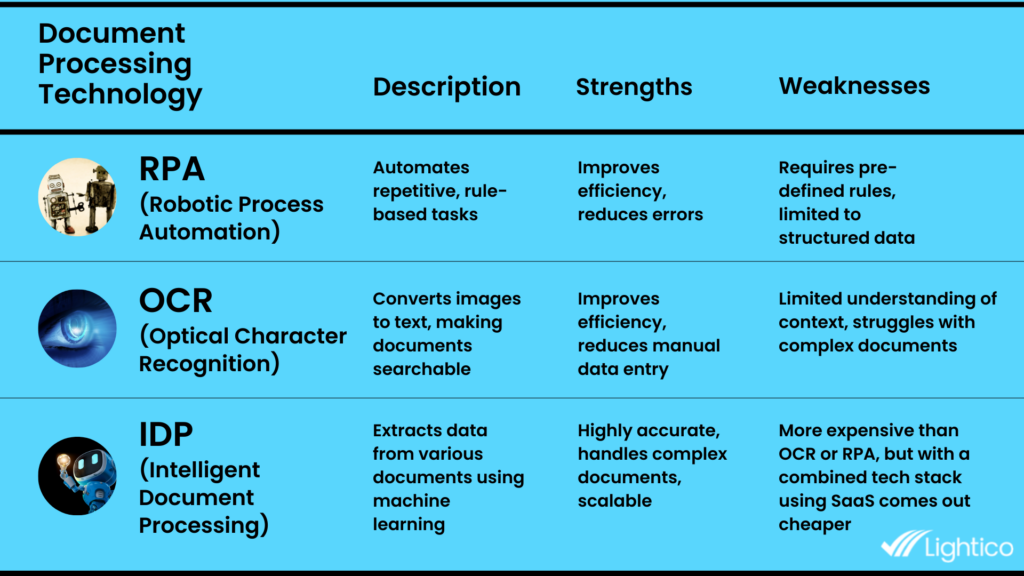Organizations, whether its banks, auto finance, or insurance, face an overwhelming influx of documents as part of their normal customer facing operations. Documents can either be internally generated and completed by customers or employees, or they can be any kind of document with information on it, such as bank statements, pay stubs, invoices, tax forms, basically any kind of document or image sent in by a customer.
Manual processing all that information and documents and agreements is slow, error-prone, and a significant drain on resources, financial and otherwise. Especially, when manual entry requires, for compliance reasons, the dreaded “stare & compare.”
Enter the realm of document processing automation—a competitive landscape where Robotic Process Automation (RPA), Optical Character Recognition (OCR), and Intelligent Document Processing (IDP) vie for supremacy.
This guide explores these technologies, highlighting their strengths and weaknesses, and ultimately positions IDP as the superior solution, especially in the financial services industry, where it can be leveraged with a generative AI co-pilot for unparalleled efficiency and accuracy.
Understanding the Technologies
RPA (Robotic Process Automation): The Mimic
Imagine a tireless software bot replicating your keystrokes and mouse clicks. RPA automates repetitive, rule-based tasks across various applications, mimicking human actions. Think data entry, form filling, and basic calculations—tasks that follow a clear set of instructions.
OCR (Optical Character Recognition): The Decoder
Struggling with scanned documents or photos filled with text? OCR is your solution. Acting as a digital decoder, it converts images of text into editable and searchable formats. It's invaluable for organizations needing to digitize paper-based documents for easier access and analysis.
IDP (Intelligent Document Processing): The Mastermind
IDP elevates automation further by combining OCR's text recognition with machine learning (ML) and natural language processing (NLP). As the ultimate document processing mastermind, IDP not only extracts text but also understands the context and meaning within documents. Think of it as an AI assistant that categorizes documents, extracts relevant data points, and validates information for accuracy.
Weighing the Pros and Cons
Here's a concise comparison of RPA, OCR, and IDP to help you choose the right technology for your document processing needs:
RPA Pros:
- Fast and Efficient: Automates repetitive tasks, significantly boosting processing speed and productivity.
- Reduced Errors: Minimizes human error by eliminating manual data entry.
- Improved Scalability: Easily scales to handle increased workloads.
RPA Cons:
- Limited Scope: Struggles with complex tasks requiring decision-making or adapting to changing formats.
- Brittle Automation: Reliant on pre-defined rules, making it fragile when processes change or exceptions occur.
- Limited Intelligence: Lacks the ability to understand context or learn from data, hindering adaptability.
OCR Pros:
- Cost-Effective: An inexpensive solution for basic document conversion needs.
- Improved Searchability: Converts scanned documents to text, making them searchable and accessible.
- Simple Integration: Seamlessly integrates with existing document management systems.
OCR Cons:
- Limited Functionality: Focuses solely on text recognition, neglecting the context and meaning within documents.
- Accuracy Issues: Poor image quality, complex layouts, or handwritten text can lead to errors in text extraction.
- Inflexible for Complex Documents: Struggles with documents deviating from standard formats or containing tables, charts, or images.
IDP Pros:
- Intelligent Automation: Leverages ML and NLP to understand document context, extracting meaningful data with high accuracy.
- Flexible and Adaptable: Handles a wide range of document formats, including structured, semi-structured, and unstructured data.
- Machine Learning Advantage: Continuously learns and improves data extraction accuracy over time.
- Streamlined Workflows: Automates document processing tasks, freeing up human resources for higher-value activities.
IDP Cons:
- Higher Cost: Requires an initial investment in technology and training compared to RPA or OCR.
- Implementation Complexity: Setting up and configuring IDP systems can be more complex than RPA or OCR. (Lightico, makes it simple. More about that later)
Why IDP Wins the Future
While RPA and OCR offer valuable automation solutions, IDP stands out as the clear winner for future-proof document processing. Here's why:
The Rise of Unstructured Data
Businesses are inundated with unstructured data such as emails, social media posts, and invoices. IDP's ability to handle such data types is crucial for comprehensive information extraction and analysis.
The Power of Machine Learning
Machine learning enables IDP to continuously improve its accuracy over time, eliminating the need for constant rule-based reprogramming—a burden associated with RPA.
Enhanced Agility and Scalability
IDP's flexibility allows it to adapt to changing document formats and data sources, future-proofing automation strategies as organizations embrace new technologies and information streams.
The Financial Services Industry: A Case for IDP with AI Co-Pilots
The financial services industry, particularly auto finance and banking, has long relied on human expertise to navigate the complexities of loan approvals. With the rise of artificial intelligence (AI), a new question emerges: should AI take the wheel entirely, or act as a co-pilot alongside human loan officers?
At AFS East, Marcelo Brutti, President & CEO of Hyundai Capital America, noted that the company was achieving 40% e-funding using Generative AI to enable faster decisions. AI is here to stay, but how soon and at what level of confidence are financial services and compliance teams ready to go fully autonomous?
AI Decisioning: Is Fully Autonomous Worth It?
Imagine an AI system analyzing mountains of financial data—credit scores, employment history, bank statements, and payslips—and instantly approving or denying loan applications. This is the promise of fully autonomous AI decisioning. Proponents tout its speed, efficiency, and potential for reduced bias. While a loan officer might take hours sifting through paperwork, an AI could make the same decision in seconds, potentially improving loan processing times and enhancing customer satisfaction.
However, compliance concerns linger:
- The AI Black Box: Opaque AI algorithms can be difficult to understand. Loan applicants might be left wondering why their application was rejected, hindering trust and transparency.
- Data Bias and Lending Bias: AI systems trained on historical data that reflects past biases can perpetuate those biases in their decisions. Imagine an AI system trained on data that unintentionally discriminated against certain demographics in loan approvals. The result could be a perpetuation of lending disparities.
AI Analyst Co-Pilot: The Human-Machine Loan Team
AI analyst co-pilot systems offer a more collaborative approach. Think of them as super-powered research assistants for loan officers. They can:
- Data Deluge Diver: Analyze vast datasets to identify patterns and trends that might escape a human reviewer, uncovering potential risks or hidden gems in an applicant's financial history.
- Visualization Virtuoso: Present complex financial information in clear, concise visuals, allowing loan officers to grasp the applicant's financial health at a glance, eliminating "stare and compare."
- Scenario Simulator: Run simulations to explore the potential consequences of different loan options, providing valuable insights for risk assessment.
Lightico's IDP features exemplify such a co-pilot system. Imagine a loan officer reviewing an auto loan application. Lightico's AI can analyze the applicant's documents together with credit report, account information, and identify potential risks based on highlighted data and if they fit within the defined parameters. The loan officer, armed with these insights, can then make a well-informed decision that best suits the applicant's situation and allows the funding team to better underwrite the lender’s risk.
The Benefits of the Co-Pilot Approach for Financial Services
The co-pilot approach offers significant advantages:
- Human Expertise Amplified: AI co-pilots provide loan officers with more information and insights, leading to faster, more informed loan decisions.
- Reduced Errors: By automating tedious tasks and flagging potential risks, AI co-pilots can significantly reduce the risk of human error in loan processing.
- Increased Transparency: Because humans remain in the decision loop, the rationale behind each loan decision remains clear and accountable. This fosters trust with loan applicants, compliance teams, and regulators.
The Road Ahead: A Balanced Future for AI in Financial Services
The future of AI in financial services will likely see a blend of both co-pilot and decisioning systems. The optimal choice will depend on factors like:
- Loan Complexity: Highly complex loans requiring nuanced understanding of the borrower's financial situation might benefit more from human expertise, while simpler, data-driven decisions could potentially be automated entirely.
- Data Availability: The quality and quantity of financial data available will influence the effectiveness of both co-pilot and decisioning systems.
- Regulatory Landscape: Regulations surrounding AI use in lending will continue to evolve, shaping how financial institutions leverage this technology.
Human-in-the-Loop Loan Approvals: Lightico's IDP in Action
Lightico's platform is designed with human oversight in mind. AI recommendations and flagging are presented as suggestions, not dictates. Loan officers and credit analysts retain control, leveraging the AI's analytical power to help make informed decisions while ensuring compliance with regulations, risk management, and ethical lending practices.
The Customer at the Forefront
Integrating IDP at the customer point of sale, or time of document upload - especially on mobile devices - greatly enhances the customer experience, and data accuracy by providing near instant feedback and convenience, allowing document completion from anywhere at any time.
This real-time processing reduces transaction times, alleviates backend workload, and ensures higher accuracy by immediately detecting and correcting issues, resulting in consistent data quality and significant cost savings through automation.
In financial services, IDP streamlines loan applications, account openings, insurance claims, and KYC procedures by enabling real-time document verification and processing. Combining IDP with generative AI co-pilots further enhances efficiency by guiding customers, improving document quality, and offering preliminary decisions, ultimately creating a faster, more secure, and transparent process.
A Glimpse into the Future Towards Autonomous AI Loan Decisions
While AI co-pilot systems offer a powerful solution in the present, Lightico acknowledges the potential for even greater automation in the future. Here's what this responsible AI decisioning might look like:
- Hybrid Systems for Streamlined Approvals: Lightico offers co-pilot and decisioning systems that work together in loan approvals. For instance, an AI co-pilot could analyze an application, identify flaws and highlight decision criteria that pass or fail lending rules, and present them to the loan officer. The human reviewer could then choose the most suitable option for next steps. This gradual shift towards automation would allow for a smooth transition and ensure human oversight remains in place for complex or higher-risk loan decisions.
- Human Oversight Guardrails: Even in more automated scenarios, Lightico emphasizes the importance of human oversight guardrails. These could include clearly defined thresholds for income, fraud, or general risk profiles that would always require human review.
- Continuous Improvement and Human-in-the-Loop Learning: Lightico recognizes the importance of continuous learning and improvement for AI systems. They envision a future where human feedback is incorporated into AI decisioning systems, allowing them to learn from past decisions and adapt over time, further refining their ability to make fair and responsible loan decisions.
IDP and AI Co-Pilots—Revolutionizing Financial Services Automation
Embracing IDP and AI technologies not only future-proofs your operations but also positions your organization at the forefront of innovation, delivering unparalleled efficiency and customer satisfaction. Lightico's solutions exemplify this approach, offering the best-in-class tools for achieving these transformative benefits.





